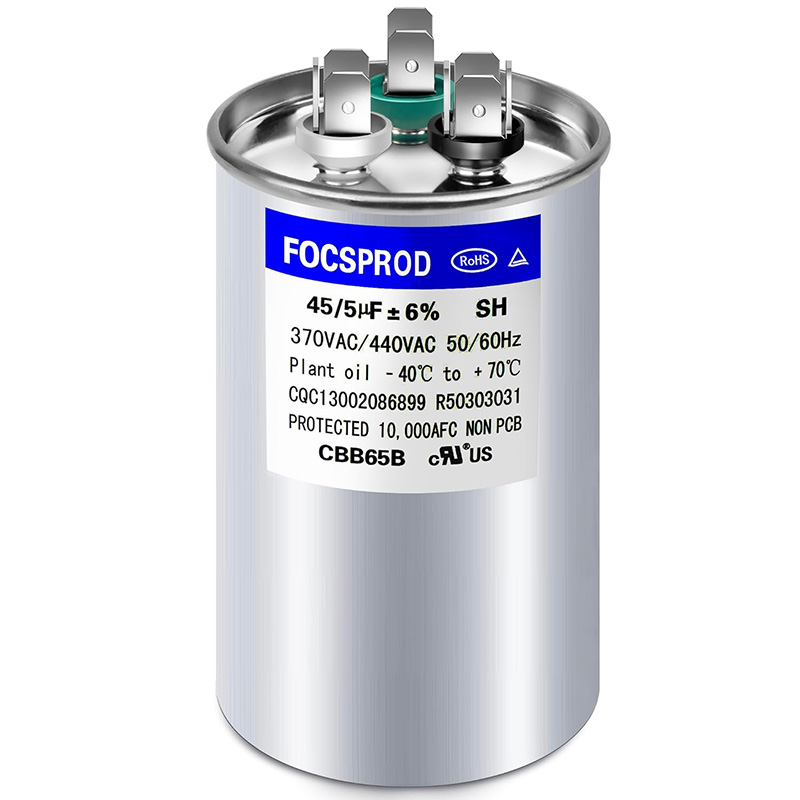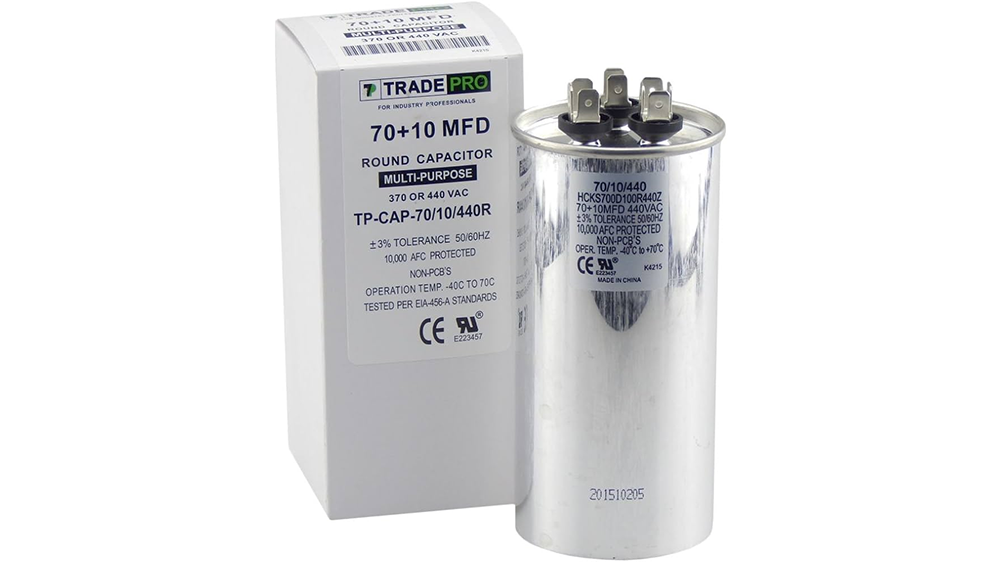In the International System of Units, the unit of capacitance is farad, abbreviated as F, and the symbol is F. Since the unit of farad is too large, the commonly used units of capacitance are millifarad (mF), microfarad (μF), nanofarad (nF) and picofarad (pF). This article will delve into a specific parameter in capacitors: MFD. We will explain what MFD is and its relationship with the capacitor unit μF.
Capacitance introduction
Since a capacitor is a "container" for storing charge, there is a problem of "capacity". In order to measure the ability of a capacitor to store charge, the physical quantity of capacitance is determined. A capacitor must be under the action of an applied voltage to store charge.

Capacitors with a capacity unit of μF
Different capacitors may store different amounts of charge under the action of voltage. It is internationally uniformly stipulated that when a capacitor is applied with a 1 volt DC voltage, the amount of charge it can store is the capacitance of the capacitor (i.e. the amount of electricity per unit voltage), represented by the letter C. The basic unit of capacitance is farad (F). Under the action of a 1 volt DC voltage, if the charge stored in the capacitor is 1 coulomb, the capacitance is defined as 1 farad, and farad is represented by the symbol F, 1F=1Q/V.
What is the unit of capacitor?
In practical applications, the capacitance of capacitors is often much smaller than 1 farad, and smaller units are often used, such as millifarad (mF), microfarad (μF), nanofarad (nF), picofarad (pF), etc. Their relationship is: 1 microfarad equals one millionth of a farad; 1 picofarad equals one millionth of a microfarad, that is:
1 farad (F) = 1000 millifarad (mF);
1 millifarad (mF) = 1000 microfarad (μF);
1 microfarad (μF) = 1000 nanofarad (nF);
1 nanofarad (nF) = 1000 picofarad (pF);
1F = 1000000μF; 1μF = 1000000pF.
What is MFD in Capacitor?
MFD capacitor full name Microfarad capacitor. MFD is the abbreviation of Microfarad, which is used to represent the unit of capacitance. On capacitors, MFD and µF are both used to represent microfarads, and these two units are equivalent. Therefore, when you see MFD marked on a capacitor, it means how many microfarads the capacitance of the capacitor is.
The units after the capacitance value of some old capacitors are marked as mFD, MD, MFD. In fact, these units, like µF, all represent microfarads.

Capacitors in units of MFD
So, whether a capacitor is labeled with "μF" or "MFD", it's indicating the same thing: the capacitance value of the capacitor in microfarads. For example, a capacitor labeled as '100 μF' or '100 MFD' has a capacitance of 100 microfarads.
It's important to note that "MFD" and "μF" are interchangeable and both represent microfarads. So if you are looking for MFD capacitors and can't find them, you can replace the MDF capacitors with µF capacitors. I believe you can find them quickly.
Why is the Capacitor Unit Expressed in MFD?
The use of the unit "MFD" on capacitors is mainly due to historical reasons and the limitations of printing technology. In the early days of electronic equipment manufacturing, printing technology may not be able to accurately print the symbol "µ", so manufacturers chose to use "MFD" to represent microfarad. This is why you will see "MFD" instead of "µF" on some older capacitors.
However, whether it is "MFD" or "µF", they both represent the same unit of capacitance - microfarad.
MFD Capacitance Equivalent Table
Below is an MFD capacitance equivalent table showing the conversion relationship between different units:
| MFD | µF | mF | nF | pF |
|---|
| 1 MFD | 1 µF | 0.001 mF | 1000 nF | 1000000 pF |
| 2 MFD | 2 µF | 0.002 mF | 2000 nF | 2000000 pF |
| 2.25 MFD | 2.25 µF | 0.00225 mF | 2250 nF | 2250000 pF |
| 2.5 MFD | 2.5 µF | 0.0025 mF | 2500 nF | 2500000 pF |
| 3 MFD | 3 µF | 0.003 mF | 3000 nF | 3000000 pF |
| 4 MFD | 4 µF | 0.004 mF | 4000 nF | 4000000 pF |
| 5 MFD | 5 µF | 0.005 mF | 5000 nF | 5000000 pF |
| 6 MFD | 6 µF | 0.006 mF | 6000 nF | 6000000 pF |
| 8 MFD | 8 µF | 0.008 mF | 8000 nF | 8000000 pF |
| 10 MFD | 10 µF | 0.01 mF | 10000 nF | 10000000 pF |
| 15 MFD | 15 µF | 0.015 mF | 15000 nF | 15000000 pF |
| 20 MFD | 20 µF | 0.02 mF | 20000 nF | 20000000 pF |
| 25 MFD | 25 µF | 0.025 mF | 25000 nF | 25000000 pF |
| 30 MFD | 30 µF | 0.03 mF | 30000 nF | 30000000 pF |
| 36 MFD | 36 µF | 0.036 mF | 36000 nF | 36000000 pF |
| 40 MFD | 40 µF | 0.04 mF | 40000 nF | 40000000 pF |
| 50 MFD | 50 µF | 0.05 mF | 50000 nF | 50000000 pF |
| 72 MFD | 72 µF | 0.072 mF | 72000 nF | 72000000 pF |
Conclusion
MFD capacitors are not obsolete. Although the unit "MFD" may be less common on new capacitors, it does not mean that capacitors using the MFD unit are obsolete. In fact, whether the capacitor is marked with "MFD" or "µF", as long as its capacitance meets the needs of the circuit, it can be used. In some specific applications or in older equipment, you may still see capacitors using "MFD" as the unit.
FAQ
1. What is the full name of MFD?
MFD stands for Microfarads, which is a unit of capacitance. This unit is often used in the field of electronics and electrical engineering to indicate the capacity of a capacitor.
2. What does MFD mean in Hindi?
MFD is the abbreviation of microfarad, a unit of capacitance. Microfarad is a scientific term that is usually used consistently in all languages, even in Hindi it is expressed as microfarad.
3. What does μF capacitor mean?
μF in the context of capacitors is an abbreviation for microfarads. This is a unit that measures the capacitance of a capacitor. For example, a capacitor marked "10 UF" has a capacitance of 10 microfarads.
4. What is the difference between μF and MFD?
Actually, μF and MFD are different names for the same unit. μF is an abbreviation for microfarads, while MFD is another common abbreviation for the unit. Therefore, for capacitors, the two terms can be used interchangeably without any difference.